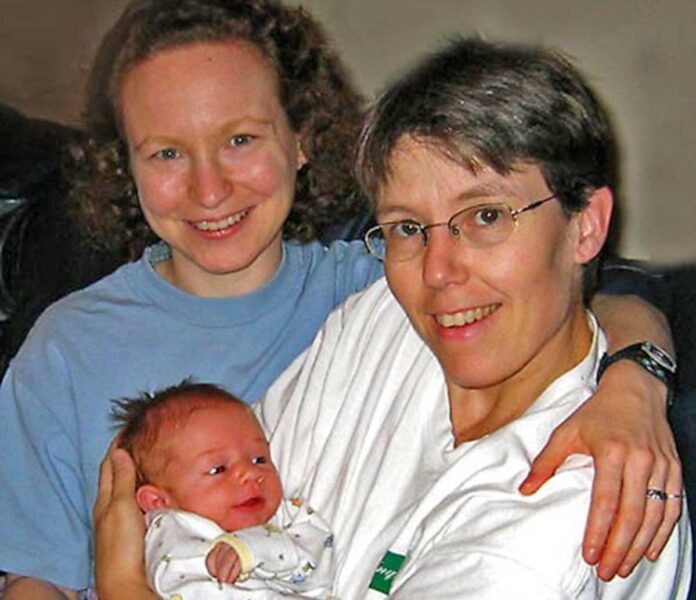My son is graduating from high school this year, which is making me reflect back to how our family started. If my social media feed is anything to go by, a lot of folks are also wanting to start their families in similar ways today, so I thought I’d share our story in hopes of offering some insight or at least inspiration (though I’m not a doctor or lawyer; please consult your own).
My now-spouse Helen and I had been together for eight years, but focused on our careers, before we decided to start a family. Once we began discussing it, we knew almost immediately that we wanted to do reciprocal in vitro fertilization (RIVF), with Helen carrying my eggs, so that we could both be a part of the process in a physical way. I’m a few years younger, so we used my “fresher” eggs.
We then juggled the three areas of healthcare, insurance, and law. First, we talked with our regular doctor and got physicals. She referred us to a fertility practice. I also approached my employer’s health insurance provider to be sure that IVF was covered — at $20,000 per attempt, we couldn’t have done it otherwise. We had to pay for the sperm ourselves, though, at about $300 per try.
Next stop was the lawyer to make sure none of the paperwork we had to sign at the clinic would waive either of our rights, since it was set up for egg donors who would not be parenting the child. We also updated our wills and powers of attorney just in case.
At the same time, we started looking at online catalogs from sperm banks. We wanted an anonymous donor who would have no possible legal claim to the child. Looking back, we might have considered a donor who was “willing to be known” when the child turned 18, but we unfortunately didn’t know this was a possibility. Mostly, we wanted someone healthy — but that still left a lot of choices. We were almost driven to putting printouts of the finalists’ profiles on the floor and choosing the one the cat sat on. (Ultimately, we made the call ourselves.)
Then began the real attempts. We met with the fertility doctor and brought home a large paper grocery bag full of medicines and needles. Helen needed to take hormones to prepare the lining of her uterus to receive the egg. I needed hormones to produce many eggs at once instead of the usual one per month.
Helen started with a “test cycle” of hormone pills to make sure her uterus responded appropriately, then I went on birth control pills to synch my cycle with hers. I still laugh about the fact that the first time I ever went on birth control was in order to have a child.
I then gave myself daily injections in my belly for several weeks. The needles were tiny and nearly painless, though I felt a little bloated as my ovaries grew.
Helen started with a daily injection via small needles, and then another for a week or so via a 2-inch needle in her backside, which I had to give her. (It was a bonding experience.)
We also both went to the clinic every other morning at 6 a.m. for blood tests and ultrasounds. We’d cut out caffeine for the duration, so that was rough, but we figured it was good preparation for parenthood.
My final injection, to release the eggs, had to be exactly 36 hours before my clinic appointment, when I went briefly under general anesthetic and woke up with the eggs painlessly removed.
The clinic then fertilized the eggs with the sperm we’d had shipped to them. Five days later they inserted the embryos via a tube into Helen’s uterus. They usually inserted more than one—this boosted the chances of any one succeeding, but at the risk of multiple births. The doctors recommended how many, based on how the embryos were developing, but the final choice was up to us. This was the most difficult question we faced after selecting the sperm donor.
We then waited for the results—a looong 10 days, especially since most over-the-counter pregnancy tests didn’t work with IVF and we had to go to the clinic. The first time didn’t succeed.
None of our remaining embryos had been good enough to freeze, so we started again from scratch. We chose a different donor, in case the sperm was the problem. I also took an additional medication to improve egg quality. Success! Helen was pregnant!
This was all before marriage equality or civil unions, however. In NJ, where we lived, I would not have been able to be on the birth certificate or have any parental rights, even though the child was genetically mine — except that with the help of our lawyer, we successfully petitioned the state for a pre-birth parentage order, making me a legal parent from the moment of our son’s birth. We thought we were going to be the first RIVF couple in the state to get such a parentage order; we ended up being the second, happy to be part of a trend.
RIVF was definitely the extra complicated (and needle-filled) route. It’s not for everyone, but we both value the different connections it has given each of us to our son. To those also considering RIVF (or any path to parenthood), I’d say be patient, try to find the humor in it, and realize it’s just the start of the long but worthwhile adventure of parenthood. Good luck!
Dana Rudolph is the founder and publisher of Mombian (mombian.com), a GLAAD Media Award-winning blog and resource directory, with a searchable database of 600+ LGBTQ family books, media, and more.

